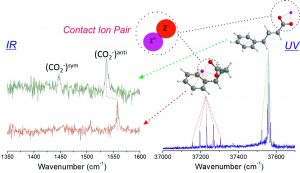Responsable : Eric GLOAGUEN
Ion Pairs
Ion pairs are ubiquitous in Nature, from sea water and aerosols, to living organisms. Being the very first step of crystallization of ionic species and influencing the properties of ion-concentrated solutions or ionic liquids, they also play a key role in countless applications. Although they are met in many areas of Physics, Chemistry and Biology, their characterization is complicated by the co-existence of several types of pairs and their elusive nature in solution.
In this context, this project aims at documenting net neutral ion pairs by investigating them in the gas phase using IR and UV laser spectroscopic techniques which enable us to characterize each type of ion pair individually. This experimental approach is combined with theoretical approaches aiming at identifiying the ion pairs formed in the gas phase, and extrapolating their vibrational signature in solution. Several questions are investigated by this project:
- the spectroscopic characterization of ion pair types, and its application to the study of the ability of solvent molecules to dissociate an ion pair.
- the influence of nearby counterions on the structure of charged biomolecules.
- the early stages of ionic crystallization.
This project is funded by:
- the French National Research Agency (2016-2020, JCJC grant number ANR-16-CE29-0017)
- the French National Computing Centers (2016-present, High Performance Computing resources, project A0050807524)
- Université Paris-Saclay (2014-2017, PhD grant of the Chemical Sciences Doctoral School of Université Paris-Saclay )
- the LabEx PALM (2014-2018, Master student grants, ANR-10-LABX-0039-PALM)
- the Japan Society for the Promotion of Science (2018, JSPS Summer Grant, J. Donon)
Collaborations:
- Pr. David J. Aitken (Institut de Chimie Moléculaire et des Matériaux d'Orsay, Université Paris-Saclay)
- Dr. Denis Céolin (Soleil Synchrotron Facility, France)
- Pr. Masaaki Fujii , Dr. Shun-ichi Ishiuchi (Tokyo Institute of Technology, Japan)
Références:
S. Habka, T. Véry, J. Donon, V. Vaquero-Vara, B. Tardivel, F. Charnay-Pouget, M. Mons, D.J. Aitken, V. Brenner, E. Gloaguen in preparation
S. Habka, “Spectroscopie optique des paires d’ions : De la caractérisation des modèles en phase gazeuse à l’identification des paires d’ions en solution”, PhD thesis Université Paris-Saclay (2017)
S. Habka, V. Brenner, M. Mons, E. Gloaguen J. Phys. Chem. Lett. 7 (7) 1192 (2016)



